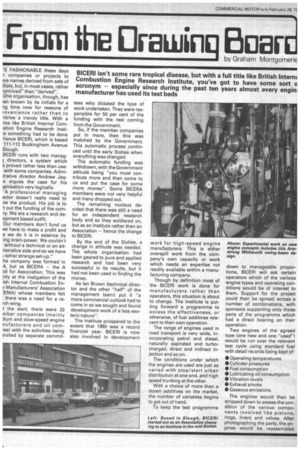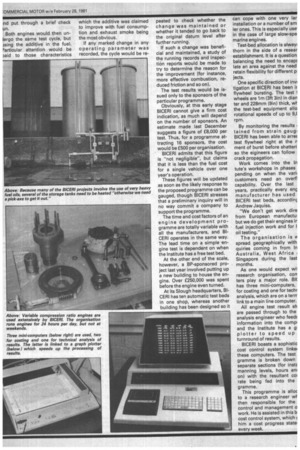From the I rowing Boer
Page 36

Page 37

If you've noticed an error in this article please click here to report it so we can fix it.
by Graham Montgomerie
'S FASHIONABLE these days r companies or projects to we names derived from sets of itials, but, in most cases, rather :ontrived" than "derived".
One organisation, though, has ;en known by its initials for a ng time now for reasons of invenience rather than to ntrive a trendy title, With a me like British Internal CornIstion Engine Research lnsti:e something had to be done hence BICERI, which is based 111-112 Buckingham Avenue Slough.
3ICERI runs with two managI directors, a system which s proved rather less than use with some companies. Admi;trative director Andrew Jags argues the case for his janisation very logically.
'A professional managing ector doesn't really need to w.r the product. His job is to 't out the funding of the corn-1y. We are a research and deopment based outfit.
Our members don't fund us rve have to make a profit and rv we do it is in essence by ing brain-power. We couldn't without a technical or an adlistrative side and so we have ; rather strange set-up."
he company was formed in 4, but as BICERA — the A Dcl for Association. This was inly at the instigation of the ish Internal Combustion En3 Manufacturers' Association :EMA) whose members felt . there was a need for a rerch wing.
t the start, there were 32 mber companies (mainly iium and slow-speed engine nufacturers and oil comies) with the activities being trolled by separate commit tees who dictated the type of work undertaken. They were responsible for 50 per cent of the funding with the rest coming from the Government.
So, if the member companies put in more, then this was matched by the Government. This automatic process continued until the early Sixties when everything was changed.
The automatic funding was withdrawn, with the Government attitude being "you must contribute more and then come to us and put the case for some more money". Some BICERA members were not very helpful and many dropped out.
The remaining nucleus decided that there was still a need for an independent research body and so they soldiered on, but as an Institute rather than an Association — hence the change to BICERI.
By the end of the Sixties, a change in attitude was needed. The whole organisation had been geared to pure and applied research and had been very successful in its results, but it had not been used in finding the money.
As Ian Brown (technical director and the other "half" of the management team) put it "a more commercial outlook had to come in so we sought and found development work of a less esoteric nature".
The Institute prospered to the extent that 1980 was a record financial year. BICERI is now also involved in development work for high-speed engine manufacturers. This is either overspill work from the company's own capacity or work which needs an expertise not readily available within a manufacturing company.
Though by definition most of the BICERI work is done for manufacturers rather than operators, this situation is about to change. The Institute is putting forward a programme to access the effectiveness, or otherwise, of fuel additives relevant to their own operation.
The range of engines used in road transport is very wide, incorporating petrol and diesel, naturally aspirated and turbocharged, direct and indirect injection and so on.
The conditions under which the engines are used are just as varied with stop/start urban distribution at one end, and high speed trunking at the other.
With a choice of more than a dozen additives on the market, the number of variables begins to get out of hand.
To keep the test programme down to manageable proportions, BICERI will ask certain operators which of the various engine types and operating conditions would be of interest to them. Support for the project could then be spread across a number of combinations, with sponsors supporting only those parts of the programme which had a direct bearing on their operation.
Two engines of the agreed type (one new and one "used") would be run over the relevant test cycle using standard fuel with detail records being kept of: • Operating temperatures • Cylinder pressures • Fuel consumption • Lubricating oil consumption • Vibration levels *Exhaust smoke • Gaseous emissions The engines would then be stripped down to assess the condition of the various components involved like pistons, rings, liners and valves. After photographing the parts, the engines would be reassembled nd put through a brief check un.
Both engines would then un!ergo the same test cycle, but ising the additive in the fuel. articular attention would be mid to those characteristics which the additive was claimed to improve with fuel consumption and exhaust smoke being the most obvious.
If any marked change in any operating parameter was recorded, the cycle would be re
peated to check whether the change was maintained or whether it tended to go back to the original datum level after further running.
If such a change was beneficial and maintained, a study of the running records and inspection reports would be made to try to determine the reason for the improvement (for instance, more effective combustion, reduced friction and so on).
The test results would be issued only to the sponsors of the particular programme.
Obviously, at this early stage BICERI cannot give a firm cost indication, as much will depend on the number of sponsors. An estimate made last December suggests a figure of £8,000 per test. Thus, for a programme attracting 16 sponsors, the cost would be £500 per organisation.
BICERI admits that this figure is "not negligible", but claims that it is less than the fuel cost for a single vehicle over one year's operation. These figures will be updated as soon as the likely response to the proposed programme can be gauged, though BICERI stresses that a preliminary inquiry will in no way commit a company to support the programme.
The time and cost factors of an engine development programme are totally variable with all the manufacturers, and BICERI operates in the same way. The lead time on a simple engine test is dependent on when the Institute has a free test bed.
At the other end of the scale, however, a BP-sponsored project last year involved putting up a new building to house the engine. Over £250,000 was spent before the engine even turned.
At its Slough headquarters, BlGERI has ten automatic test beds in one shop, whereas another building has been designed so it can cope with one very lar installation or a number of sm ler ones. This is especially use in the case of large slow-spe marine engines.
Test-bed allocation is alwar thorn in the side of a resear establishment. It is a question balancing the need to encap; late an area against the need retain flexibility for different pr jects.
One specific direction of invi ligation at BICERI has been ir flywheel bursting. The test wheels are 1m (3ft 3in) in dian ter and 228mm (9in) thick, the test-bed equipment allo rotational speeds of up to 9,C rpm.
By monitoring the results 1 tamed from strain gaugi RICER! has been able to arre: test flywheel right at the ri ment of burst before shatteri so the eigineers can follow crack propagation.
Work comes into the In tute's workshops in phases pending on when the vanil customers need an overfl capability. Over the last years, practically every eng manufacturer has used BICERI test beds, accordinc. Andrew Jaquiss.
"We don't get work dire from European manufactur but we do get their engines ir fuel injection work and for I oil testing."
The organisation is v spread geographically with quiries coming in from In Australia, West Africa ; Singapore during the last months.
As one would expect wil research organisation, con ters play a major role. BR has three mini-computers, for costing and one for techr analysis, which are on a terrr link to a main line computer.
All engine test result sh are passed through to the analysis engineer who feed; information into the compi and the Institute has a gl plotter to speed up turnround of results.
BICERI boasts a sophistic cost control system linke( these computers. The test gramme is broken down separate sections (for instz manning levels, hours an( on) with the resultant co: rate being fed into the gramme.
This programme is alloc to a research engineer wF then responsible for the control and management o work. He is assisted in this b cost control system, which ( him a cost progress state; every week.




























































































